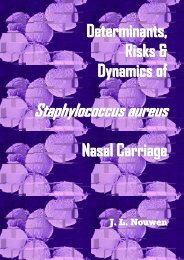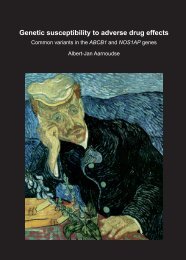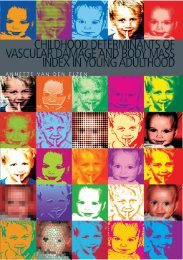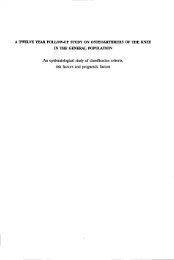An attempt at an epidemiological explanation - Epib.nl
An attempt at an epidemiological explanation - Epib.nl
An attempt at an epidemiological explanation - Epib.nl
- No tags were found...
Create successful ePaper yourself
Turn your PDF publications into a flip-book with our unique Google optimized e-Paper software.
ChapEe,. 7In this thesis several aspects of the epidemiology of meningococcal disease in theNetherl<strong>an</strong>ds have been addressed. The core theme was studying the spread of meningococcaldisease in the Netherl<strong>an</strong>ds in the past decade in <strong>an</strong> <strong><strong>at</strong>tempt</strong> to explain theincreased incidence in the 19805. This was done by observing several characteristics ofthe p<strong>at</strong>hogen, which took a central position in this thesis, <strong>an</strong>d the host. TIle ultim<strong>at</strong>egoal was to provide inform<strong>at</strong>ion which may assist the (future) prevention of meningococcaldisease. In the following three sections the relev<strong>an</strong>ce of the results of thevarious chapters will be discussed in retrospect, <strong>an</strong>d recommend<strong>at</strong>ions fo r furtherresearch will be given. The first section discusses the factors th<strong>at</strong> are rel<strong>at</strong>ed to th eincreased incidence of meningococcal disease, the second section deals with aspectspertaining to the future vaccine, <strong>an</strong>d the third witb chemoprophylaxis.Increased incidence of meningococcal disease in the Netherl<strong>an</strong>ds from 1980 to 1990Epidemic or endemic?Neisseria meningilidis is capable of causing ep idemics of meningococcal disease (MD),<strong>an</strong>d epidemics have been reported world-wide, as well as in the Netherl<strong>an</strong>ds. l2During the 1980s the incidence of MD in the Netherl<strong>an</strong>ds increased gradually froml.l/l00,000/year in 1982 to 3.5/100,000/year in 1990. At the end of 1988, alarmingreports appeared in the lay press, which gave rise to much concern among the public,<strong>an</strong>d the question was, whether we had to fear <strong>an</strong>other epidemic of MD.It is difficult to give <strong>an</strong> exact definition of <strong>an</strong> epidemic. In a h<strong>an</strong>dbook on theepidemiology of bacterial infections the following definition is given: 3 "<strong>An</strong> epidemic issaid to exist when <strong>an</strong> unusual number of cases of a disease occur in a given tim eperiod <strong>an</strong>d geographic area as compared with the previous experience with th<strong>at</strong>disease in th<strong>at</strong> area". It is also st<strong>at</strong>ed th<strong>at</strong> this definition is arbitrary <strong>an</strong>d will varyfrom disease to disease. The problem is bow to determine wh<strong>at</strong> should be consideredas <strong>an</strong> unusual number. For the design<strong>at</strong>ion "epidemic of MD in the Netherl<strong>an</strong>ds" <strong>an</strong>arbitrary cut-off value of 4.0 cases per 100,000 inhabit<strong>an</strong>ts per year has been applied.'According to tbis definition, the increased incidence of MD in the Netherl<strong>an</strong>ds in thel<strong>at</strong>e 1980s c<strong>an</strong> not be considered <strong>an</strong> epidemic, because it did not exceed this cut-offvalu e. However, if the estim<strong>at</strong>ed 80% coverage r<strong>at</strong>e of the submissions of meningococcito tlle Netherl<strong>an</strong>ds Reference Labor<strong>at</strong>ory for Bacterial Meningitis (RLBM) istaken into consider<strong>at</strong>ion,S the true incidence in 1990 would have been around4.3/l00,000/year, which would then meet this criterion.It c<strong>an</strong> be argu ed th<strong>at</strong> this nominal criterion for the definition of <strong>an</strong> epidemic ofMD alone will not suffice, <strong>an</strong>d th<strong>at</strong> other aspects should be considered as well. Oneof these aspects is the r<strong>at</strong>e of the increase in frequency of the disease, which dependson the dur<strong>at</strong>ion of the incub<strong>at</strong>ion period of the disease. Most epidemics of MD, asreported in the past, showed a sudden steep rise in the number of cases in a shortperiod of time, which is in agreement with the short incub<strong>at</strong>ion period of MD,)foll owed by a rapid decrease l 26 The 1966 epidemic in the Netherl<strong>an</strong>ds is a good86









